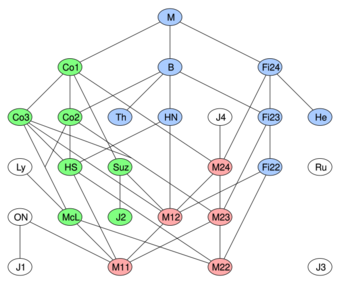Pariah group
From HandWiki
In group theory, the term pariah was introduced by Robert Griess in (Griess 1982) to refer to the six sporadic simple groups which are not subquotients of the monster group.
The twenty groups which are subquotients, including the monster group itself, he dubbed the happy family.
For example, the orders of J4 and the Lyons Group Ly are divisible by 37. Since 37 does not divide the order of the monster, these cannot be subquotients of it; thus J4 and Ly are pariahs. Three other sporadic groups were also shown to be pariahs by Griess in 1982, and the Janko Group J1 was shown to be the final pariah by Robert A. Wilson in 1986. The complete list is shown below.
| Group | Size | Approx. size |
Factorized order |
|---|---|---|---|
| Lyons group, Ly | 51765179004000000 | 5×1016 | 28 · 37 · 56 · 7 · 11 · 31 · 37 · 67 |
| O'Nan group, O'N | 460815505920 | 5×1011 | 29 · 34 · 5 · 73 · 11 · 19 · 31 |
| Rudvalis group, Ru | 145926144000 | 1×1011 | 214 · 33 · 53 · 7 · 13 · 29 |
| Janko group, J4 | 86775571046077562880 | 9×1019 | 221 · 33 · 5 · 7 · 113 · 23 · 29 · 31 · 37 · 43 |
| Janko group, J3 | 50232960 | 5×107 | 27 · 35 · 5 · 17 · 19 |
| Janko group, J1 | 175560 | 2×105 | 23 · 3 · 5 · 7 · 11 · 19 |
References
- Griess, Robert L. (February 1982), "The friendly giant", Inventiones Mathematicae 69 (1): 1–102, doi:10.1007/BF01389186, ISSN 0020-9910, Bibcode: 1982InMat..69....1G, https://deepblue.lib.umich.edu/bitstream/handle/2027.42/46608/222_2005_Article_BF01389186.pdf
- Robert A. Wilson (1986). Is J1 a subgroup of the monster?, Bull. London Math. Soc. 18, no. 4 (1986), 349-350
 |


